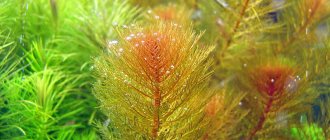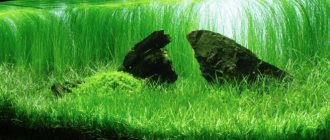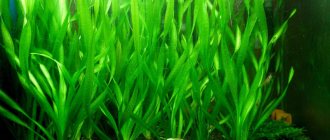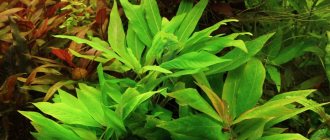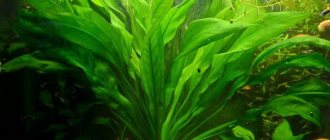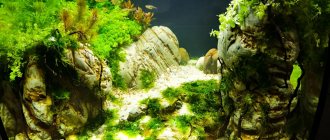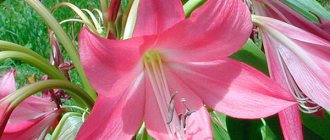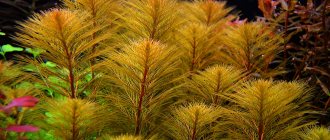Alternanthera is a semi-shrub perennial herbaceous plant. The genus includes about 200 species. From Latin alternans is translated as “changeable.” The plant comes from the subtropical regions of America, Australia, Africa and the Galapagos Islands. The plant is suitable for ponds and aquariums, as well as for garden plots.
Among themselves, Alternanthera species may differ in leaf color and size. The color of the foliage can be from light green to bright red, the flowers are small and inconspicuous. The plant is highly decorative, which attracts the attention of gardeners and landscape designers. A distinctive feature of the bushes is that their color can change depending on the brightness of the lighting.
For flower beds, you can select the Brazilian alternanthera, with an unusual red-green color and an orange tint of leaves. Among the aquarium species, we can note Reineck's alternanthera. The leaves of this species are also red-green, but very brittle and fragile. The leaves are about cm long. The varieties are narrow-leaved, triangular-leaved, merchant-leaved, and large-leaved.
Alternanthera care
A distinctive feature of the plant is that it is grown both in flower beds and in pots, as well as in aquariums. Care is not burdensome, but you should carefully consider the following rules:
1. Alternanthera prefers bright light. If the color is kept bright, the color of the leaves becomes richer. With poor lighting, the leaves turn pale and lose their decorative effect. 2. In summer, the plant needs to maintain a temperature ranging from +25 to + 28 degrees, and in winter from +15 to + 17. 3. In order for the plant to bloom, it needs high humidity. When growing a plant in an aquarium, waiting for flowering is much easier.
Description
Alternanthera is a semi-shrub perennial or annual (depending on the genus) herbaceous plant. Its homeland is the subtropical regions of America, Australia, Africa and the Galapagos Islands.
This plant came to Europe along with South American importers back in the 70s. Today it is grown in various parts of the world. Due to its spectacular appearance, this plant is especially popular.
Please note that alternanthera is suitable for both ponds and aquariums, and for garden plots.
There is a wide variety of species - over 200 varieties. Among them there are both perennial and annual semi-shrubs. All types differ from each other in shade and leaf size. It can be either light green or bright red in color.
Interesting fact: Translated from Latin, “alternans” means “changeable.” The plant got its name for a reason. Its color may change depending on the lighting.
Watering alternanthera
When growing a plant in an aquarium, you only need to keep the water fresh, because... In stagnant water, bushes grow much more slowly. For bushes in pots or in open ground, maintain the usual watering regime - i.e. Watering is carried out as the top layer of soil dries. Avoid overwatering the soil, which can lead to rot in the roots.
Appearance
All types of alternanthera have counter or opposite leaves. The main feature of the appearance lies precisely in the color of the foliage. As a rule, it is much brighter than flowers. All varieties are low growing. They can be given any shape, as they tolerate cutting quite well.
Due to its bright and spectacular appearance, alternanthera is used as a decorative element for decorating flower beds or aquariums.
Diseases and pests
If there is excess moisture, gray rot may form in the alternanthera. In this case, you need to change the watering regime, remove the affected parts of the plant and treat the bush with any fungicide, for example, copper sulfate. Among the pests, the plant is susceptible to attack by aphids, whiteflies and spider mites.
Aphids feed on the juices of plant leaves. Soapy water, infusion of garlic, onion or tobacco helps against aphids. Suitable medications include Aktar, Fitoverm, and Karate.
The whitefly lives under the leaves of the plant and lays its larvae there. The leaves of the bush begin to wither from the waste products of the larvae. It is necessary to ventilate the plant, because Whiteflies appear where there is high humidity.
Spider mites can be recognized by the white coating and the appearance of cobwebs on the leaves. The leaves are starting to dry out. To get rid of spider mites, the same methods are suitable as for aphids: soap solution or insecticides.
When using insecticides, precautions must be taken, because The drugs are toxic and using them at home is dangerous! When growing Alternanthera in an aquarium, you should carefully select the fish and their number. Some types of fish can bite off the leaves of a plant, which will negatively affect its decorativeness and even development. A damaged plant may stop growing.
How to water
— Watering for this indoor plant should be moderate but regular. It is not allowed to overdry the earthen clod.
— Feeding is carried out in the spring-summer period once every two weeks, and you can use mineral and organic fertilizers. In winter and autumn, the plant does without additional nutrition.
Reproduction of alternanthera
Alternanthera reproduces in two traditional ways: seed and vegetative. Propagating a plant by seeds is a rather labor-intensive option, which, moreover, does not bear the same fruit as vegetative propagation.
When cuttings, the cuttings are prepared in advance in the fall. The cuttings are planted in the ground and dug up to the first leaf. The container is covered with film or glass and placed in a lighted place, but without direct sunlight. The length of the prepared cuttings must be at least 10 cm and have 8-10 leaves. The soil needs to be watered and ventilated.
As soon as the cuttings begin to grow, the top can be pinched to form side shoots. After about 10 days, the first roots will appear. At the end of May, when the threat of night frosts has passed, the plant can be planted in open ground. To obtain lush bushes, several seedlings can be placed in one hole. When propagating in an aquarium, the cutting should be left on the surface of the water. When the first roots appear, it can be buried in the substrate.
Kinds
Based on the leaf shape, all types of alternanthera are divided into 4 groups:
- Large-leaved, tall. A prominent representative of this group is Juvel. The large leaves of this species have a rich, bright color. The upper foliage is most often carmine red in color.
- Narrow-leaved, low-growing. Among the representatives of this group one can distinguish A.amoena f. Rosea. This is a small plant with neat leaves that seem very fragile. The color of the leaves is bright red.
- Narrow-leaved and curly-leaved. Here the species A. Paranychioi can be distinguished. Its main feature is its original appearance. The height of the plant rarely exceeds 10 cm. The color of the leaves differs from the previous groups. It's darker. Many varieties have brick-colored foliage. There are also species with yellow leaves.
- Broad-leaved and triangular-leaved. Representatives of this group can be considered using the example of the species A. Versicolor. Its main feature is the glossy surface of the sheet. It has a beautiful purple or color. Broad-leaved species grow and develop faster than all other groups. However, they do not like the cold, so they may not take root.
Among the 2000 varieties of Alternanthera, there are many spectacular and attractive representatives of this genus. The most beautiful and unusual of them deserve special consideration.
Reineka
It belongs to the Amaranthaceae Alternanthera family. South America is considered its homeland. This species has a fibrous root system. It develops quite widely and quickly, while the roots themselves are very thin. The bush itself resembles tall grass. The foliage is located perpendicular to the soil. Its characteristic feature is its pointed tip. The leaf length can reach 4 cm and the width 0.5 cm.
Reineka has a variable color. For example, the upper foliage may have a brown-brown tint, and the lower foliage may be scarlet. The height of the plant also varies. It can grow up to 20 cm or up to 500 cm. In the summer, Reineka begins to bloom. The inflorescences are rather inconspicuous. Against the background of bright foliage, pale pink or yellow small flowers remain almost invisible.
This species is often used to decorate an aquarium. Underwater, the stems grow upward. If you want the height of the plant to reach the very top of the aquarium, then do not deepen it too much. However, in this case, it is important to take into account that the top sheet of Reineka should not come out of the water. To avoid this, pinching should be done. This procedure promotes branching of the stem, due to which the plant will become lush and beautiful.
The main advantage of this type is rapid growth. In 1 month it can grow up to 15 cm. The main thing is to comply with the required conditions of detention. The water temperature should be 24-28 degrees. The plant tolerates temperatures dropping to 20 degrees, but in this case its growth slows down. Permissible water hardness is 2-12°, pH 6.2-6.8. Once a week it is necessary to replace 20% of the fluid volume.
Lilac
Thanks to its color, it stands out from other plants. The lilac alternanthera will become the main decoration of the aquarium, transforming it favorably. This species has long leaves of an interesting epileptic shape. Most often, the foliage located below has a bright burgundy color. At the top, the leaves are a completely different color - rich green.
Tip: If you want to make the shade of the foliage even more intense, add carbon dioxide to the water.
Lilac alternanthera is characterized by difficult conditions of detention. The water must be very clean. Good filtration is essential. You will also need to regularly clean the aquarium and change the water every week (about 1/5 of the volume). This species grows slowly, so it is recommended to choose rich soil enriched with microelements.
sedentary
Mainly lives in water bodies of South America. Belongs to the amaranth family Alternanthera. It is a long-stemmed plant with beautiful leaf colors: from pink-green to lilac-red. Lanceolate leaves with noticeable lateral veins and short petioles extend from the stem, which is round in cross-section. The leaf length reaches 8 cm and the width 0.5 cm.
Popularly this species is called “Over-Anther”. It received its official name (“sessile”) due to the arrangement of the inflorescences.
This type includes 2 subgroups:
- Alternanthera sessilis var. Lilacina - easily takes root in any place with a warm and humid climate. The leaves are mostly green in color. This subspecies is unpretentious and therefore does not require special care.
- Alternanthera sessilis var. Rubra - in just 1 week it can grow up to 20 cm. It branches quite well, making it look very lush. The leaves have an emerald hue. The subspecies blooms with small scarlet flowers.
Sessile alternanthera can be grown both under water and in open ground. In this case, the color of the foliage will be different.
Betsika
This is a perennial plant from the Amaranth family. It has another name - “Betzikiana”. This species is native to Brazil. Betsika easily adapts to high humidity conditions. In its natural environment, it can be found both in water and on land near wetlands. Based on this, at home it is preferable to grow alternanthera in a tropical aquarium.
The leaves have a pointed shape. Bright flowers can be seen at the tips of the stems. In an aquarium, the plant grows up to 15-20 cm, and in natural conditions - up to 50 cm.
Green
This subspecies is native to Brazil. It got its name due to the color of its leaves. They have a green tint. The height of the plant reaches 20 cm. With proper care, small pink flowers bloom.
When growing this species, it is especially important to monitor the temperature. If it drops to 18°C, the plant will die. Another important condition is that the water must be changed every week.
Content Features
Let's look at the main features of alternantera content.
- It is recommended to plant the plant along the side bases or in the center of the background.
- When growing alternanthera, you should not allow the shoot to grow above the water level. To do this, trim the top. The cut cuttings can then be planted.
- The plant requires bright light. With a lack of light, the bright red and pink leaves will remain plain green. For lighting, sources with strong luminous fluxes and a spectrum that stimulates photosynthesis are suitable. The duration of daylight hours is selected individually. The optimal value is 9-12 hours.
- Requires the addition of CO2 gas or liquid carbon from Tetra.
- Fertilization is necessary, especially in the case of the Reineck species. The main component will be iron. Liquid formulations from Tetra are ideal.
- Proper care will require a water change (up to 20%).
- Optimal temperatures are 22-28 degrees Celsius.
Use in landscape design
Alternanthera is ideal for decorating a personal plot. It is most often used as an annual decorative foliage plant. In this case, there is no need to replant it in a greenhouse for the winter.
This plant can rightfully be called the star of carpet floriculture. It is small in stature, tolerates shearing well and has a large number of colors, which is ideal for using this plant for carpet beds, borders, alpine slides, floral designs, and figured compositions. With the help of a professional haircut, you can give the bush a different shape - ovoid, spherical, comb-shaped.
This plant is also a decoration for any underwater landscape. It attracts attention with its bright color and serves as the main element of the aquarium installation. Alternanthera is used to decorate not only aquariums, but also ponds. These species include Alternanthera sessilis, Alternanthera reineckii.
Alternanthera rhineca is an ideal plant for those who want to create a tropical exotic atmosphere in the aquarium. The growth rate is quite high, about 15 cm per month, which allows you to quickly bring your planned compositions to life. When creating compositions, you do not need to plant the bushes very densely, as they are quite fragile. You should not forget to pinch the upward-stretching stems in time. This will lead to an increase in their branching and give the plant an even more beautiful appearance.
This species is used for growing in greenhouses. Under good conditions, the plant will grow into lush bushes with bright purple leaves.
Alternanthera violet is used to decorate aquariums, ponds and greenhouses in humid tropical climates. Thanks to the different colors of the upper and lower sides of the leaves, the plant has a simply fabulous appearance. It is a decoration for any aquarium. Bushes should be planted in small groups in the center or closer to the side walls of the aquarium. This will give the underwater landscape a very picturesque look.
Alternanthera sessile is used to decorate small bodies of water. In the summer, it is planted at the bottom in shallow places or along marshy banks. In small aquariums, they decorate the walls of the container with it, planting up to 15 plants. In large volume aquariums, it is planted in places in the middle, which makes it possible to form beautiful bushy islands.
How to propagate
— Reproduction can be carried out throughout the growing season. We use methods such as cuttings or dividing the bush. We cut the cuttings at an angle, remove the lower leaves and plant them in the ground, deepening them to the first leaf. We crush the soil and cover it with a jar. Place the pot in a warm place. As soon as new leaves appear, this will mean successful rooting of the cuttings. After new leaves appear, the container that covered the cuttings can be removed. The tops of the plant are pinched to develop branching.
We plant several specimens at once in a permanent pot.
If the plant has completely grown out of the pot, we use division for propagation: remove the plant from the pot, carefully separate the shoots and roots. If the roots are too long, they can be trimmed painlessly. The plant will react to this calmly. For further adaptation of the transplanted specimen, it is better to use a bright and warm place.
Alternanthera reineckii
There are several points of view regarding the homeland of the Alternanthera species that is most often found in our aquariums - Alternanthera reineckii. It is traditionally believed that this plant comes from the swamps of South America (Brazil and Paraguay), but a number of scientists consider it a variable cosmopolitan (including several other related plants originating from other parts of the world to this species), and some even consider Alternanthera Reineck to be artificial bred form: it is too difficult to believe that a plant with such incredible leaf color can arise in nature.
Alternanthera came to Europe in the mid-1960s, and, thanks to the efforts of the outstanding aquarist and aquarium popularizer Mark Davidovich Makhlin, it immediately found its way into the hands of domestic hobbyists.
Strictly speaking, even this alternanthera is not a completely aquatic plant. This inhabitant of tropical swamps feels much more comfortable in a paludarium or a damp greenhouse, in a semi-aquatic position, with his nose sticking out, above the water. But even in a completely immersed state, it is capable of living for as long as desired without degrading or losing its exotic beauty.
Alternanthera is a typical “long-stemmed” plant; it needs to be planted in an aquarium in large groups of 5-10 stems to create a beautiful and compact red bush. However, I would not recommend planting them directly in a bunch, a “bouquet”, as is often done with rotals and other less demanding plants: the stems of the alternanthera are brittle, and the leaves are prone to rotting in close quarters, so in such a “broom” the plants will interfere with each other friend, “strangle” neighbors. Therefore, alternanthera stems need to be planted with a small interval from each other.
In order for the alternanthera leaves to acquire the correct, bright red color, and the stems not to stretch or break, it requires proper care. First of all, it needs fairly bright light: the anthocyanin pigment, which gives the leaves a red color, is actively formed only in bright light, and in insufficient light the plant begins to turn green. For the same reason, it is necessary to “play” quite subtly with the length of daylight hours: if you set it to 12 hours, then the alternanthera will be bright, but all sorts of unwanted algae - filamentum, xenococcus, tropical cladophora - will be no less happy about such a long day. If you shorten the day to 8-9 hours, then the alternanthera will “complain” about the lack of light for bright colors. The balance is somewhere around 10-11 o'clock.
Alternanthera stems quite quickly stretch upward, towards the surface of the water. But under no circumstances let her climb up and give off airy leaves: as soon as this happens, she will immediately begin to “go bald”, shedding the lowest rows of underwater leaves: she no longer needs them. Therefore, as soon as the tip of the top leaf reaches the surface, carefully break off the stem of the plant at a depth of 5-10 centimeters from the surface, so that at least four pairs of leaves remain on the torn top, and plant the torn tip in the ground. It will quickly give new roots and begin to grow, and the topless plant will begin to branch, forming a beautiful red bush.
Alternanthera receives nutrients mainly from water, through short adventitious roots growing at the base of the leaves. Thin branched ground roots serve more for anchoring in the ground than for nutrition. Therefore, for feeding you need to use liquid iron(II)-containing fertilizers for aquarium plants. And, of course, it is advisable to supply CO2 to the aquarium for a balanced diet.
Fertilizers
Tetra PlantaMin Aquarium Pharmaceuticals Leaf Zone Dennerle V30 Aqua Medic Ferrial Sera FLORENA The
world-famous aquatic plant researcher Christel Casselman, having studied the variety of color forms and variations of Alternanthera Reinecka contained in aquariums, came to the conclusion that they all come down to four forms or subspecies: nominal (with a red-brown color and a corrugated leaf edge), "Grunblattrig" (brownish-olive), "Rotblattrig" (orange-red) and "Lilablattrig" (red-violet). At the same time, K. Casselman notes that she is not sure of the natural origin of these forms, and it is very likely that some of them were bred and fixed artificially.
In addition to this type of Alternanthera, two more species are found in aquariums (but somewhat less frequently) - Alternanthera sessile (or sessile-leaved) and Alternanthera lilac.
The benefits and harms of the plant
Alternanthera is harmless to all inhabitants of the aquarium. It does not grow aggressively, so it cannot displace other species.
In addition, the benefits of this algae include:
- the ability to saturate water with oxygen;
- formation of a refuge for many species of fish and shellfish;
- unpretentiousness to soil composition;
- highly decorative;
- possibility of forming a dense carpet, etc.
The disadvantages of the plant include its whimsicality. With insufficient light and nutrients, alternanthera can shed all its leaves. If unfavorable conditions persist for a long period, the plant dies.
Spreading
In its natural environment, alternanthera can be found in marshy areas of a warm climate zone. Thus, wild varieties grow in the countries of South America - Brazil, Paraguay. Some varieties are found in the southern regions of North America.
The species are native to the tropical region, so their distribution range includes Asia and northern Africa. Most of the species grow in Australia.
Cultivated varieties can grow both in water and in soil. Various Alternanthera crops grow in almost all regions and climatic zones. Thus, aquarium plant varieties thrive in the temperate climates of Russia, Ukraine and the Caucasus. With proper care and cultivation in a temperate climate, it is possible to grow both annual and perennial varieties of alternanthera.


